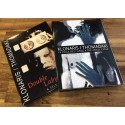Pack of 2 DVDs with films by Maria Klonaris & Katerina Thomadaki at a special discount price
 Our terms and conditions of use
Our terms and conditions of use
(edit with the Customer Reassurance module)
 Delivery policy
Delivery policy
(edit with the Customer Reassurance module)
DOUBLE LABYRINTHE
Although consciously placed at the intersection of two great traditions, that of the ritual filmmakers (S. M. Eisenstein, Maya Deren, Kenneth Anger...) and that, less abundant, of the women filmmakers and visual artists (Germaine Dulac, Maya Deren again, Carolee Schneemann...), the work of Maria Klonaris and Katerina Thomadaki is unlike any other. Completely driven by a study of the body’s representation, it has devised brilliant aesthetic means and produced numerous theoretical tools to visually express their critical and affirmative philosophy.
-Nicole Brenez
These two artists, these two women, produced the concept of ‘a double author’, which is, to my knowledge, unique. [...] Double Labyrinth as the crucible and first instance of their work together provides a beautiful figuration of how the politics of method, the creative double, inflected the poetics of its imagery, the women’s bodies and their expressivity.
-Laura Mulvey
In their films they tackle the question of the femininity of images and of women in images, a major question when you consider the role of women in the history of images or in the history of painting. However, for them, what is at stake is not building femininity in opposition to masculinity or virility, but discovering the pure otherness at the core of what is feminine. Beginning with what are considered feminist themes, they end up with a broader theme, which is strictly and radically political and which is the question of the Other.
-Marie José Mondzain
Double Labyrinthe’s minimal yet complex aesthetics launched Klonaris/Thomadaki’s “Cinéma corporel.” The impact of the film on the experimental film scenes of the time, both in Paris and London, was such, that it actually helped to transform them. Its “radical femininity” trail blazed new dimensions in feminist film practice and theory, which to this day appear as innovative as in 1976. This landmark film holds a singular place next to such gems as Meshes of the Afternoon, Fuses or Jeanne Dielman.
-Cécile Alex Chich
DOUBLE LABYRINTHE, 1975-1976, 50mins
LA TORTURE, 1976/2012, 15mins
FLASH PASSION, 1970, 2mins
3.VIl. 1973, 1971, 6mins
SMOKING, 1976/2016, 4mins
The Angel Cycle : Selected Works
Maria Klonaris and Katerina Thomadaki are cutting-edge experimental filmmakers, the founders of “corporeal cinema” and creators of projection environments, instigators of innovative approaches to photography and pioneers in media crossover. The conviction and theoretical thrust of their work highlight a need to rethink contemporary art in light of new technological tools as well as today’s scientific, social and philosophical concerns.
-Christian Gattinoni
Maria Klonaris and Katerina Thomadaki have created new connections between the living body’s presence and the figurative analysis of icons; between performance and recording; between still images, moving images and the mobility of media; between mythographies and modernity. Their quest, pioneering in so many ways, also goes beyond the disastrous division which plagues the avant-garde, between the cinema as a visual art and the cinema of political action.
-Nicole Brenez
FILMS
REQUIEM POUR LE XXE SIECLE, 1994, 14mins
PERSONAL STATEMENT, 1994, 8mins
PULSAR, 2001, 14mins
QUASAR (2003) 32mins









